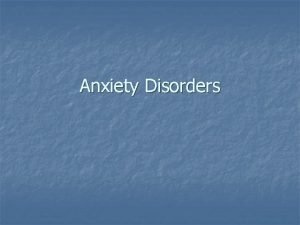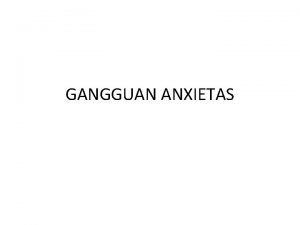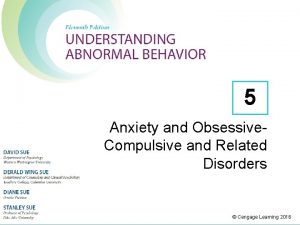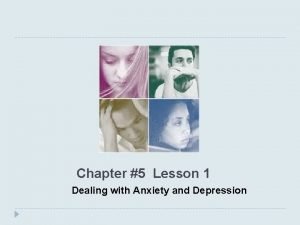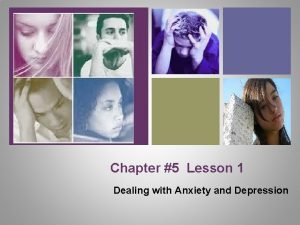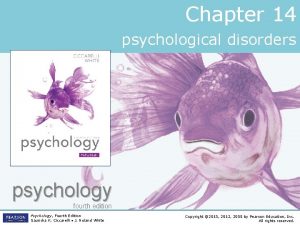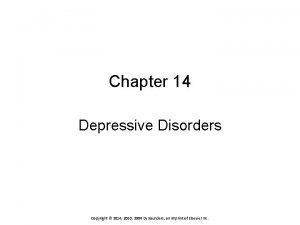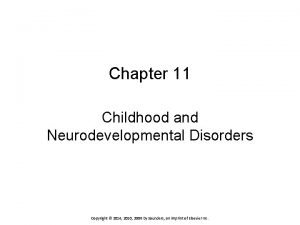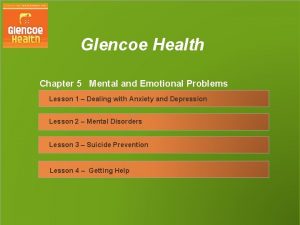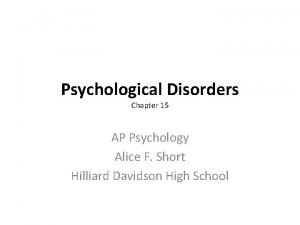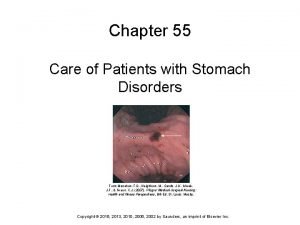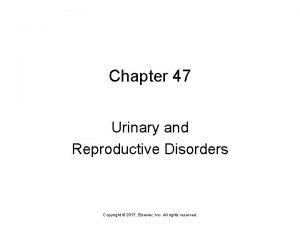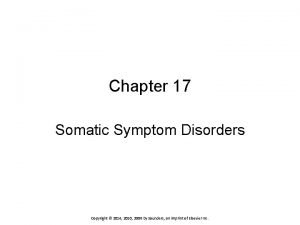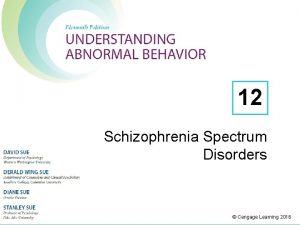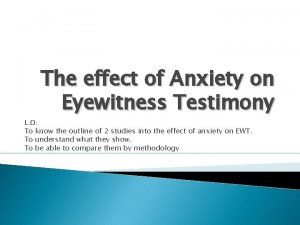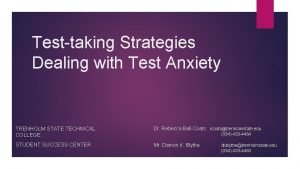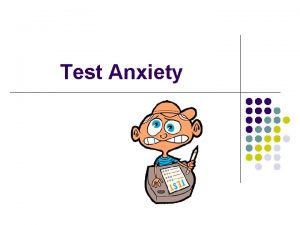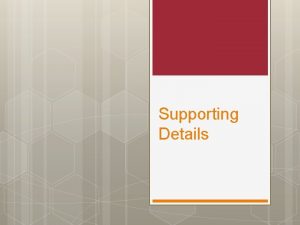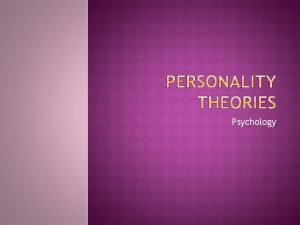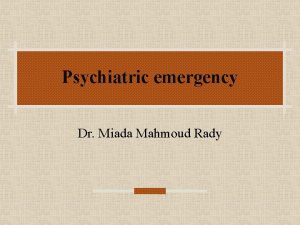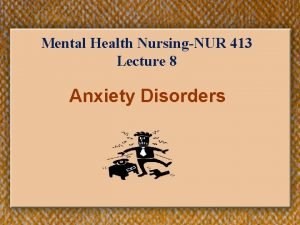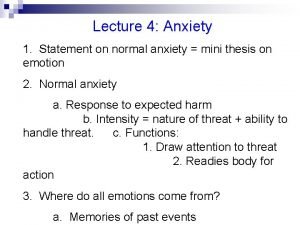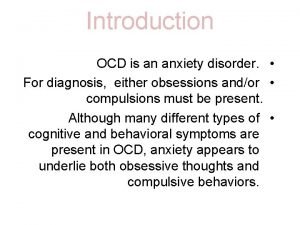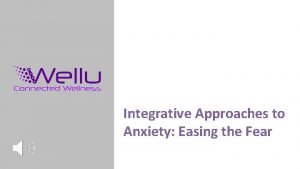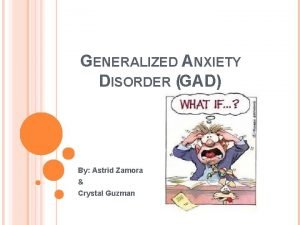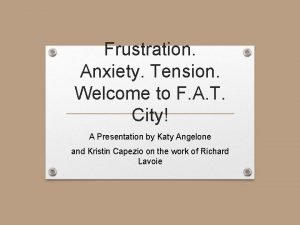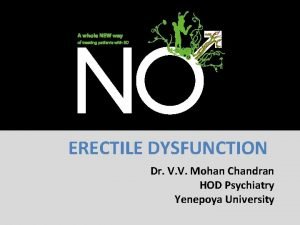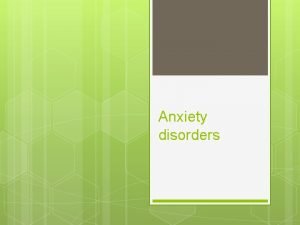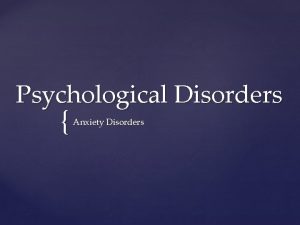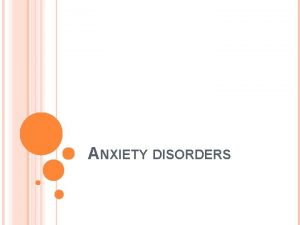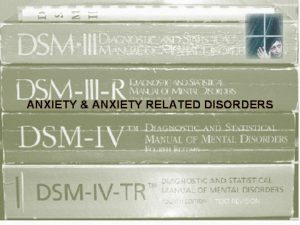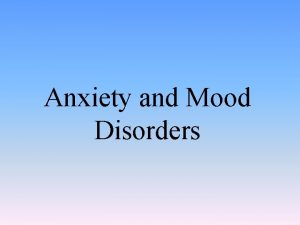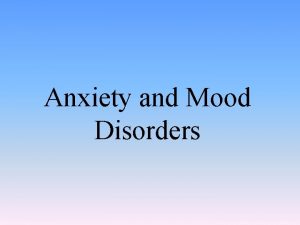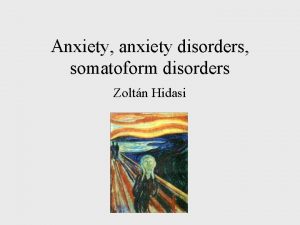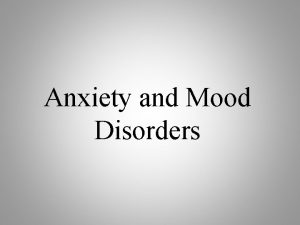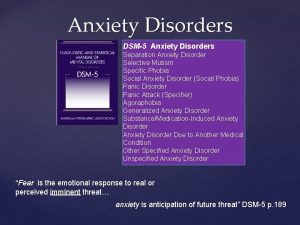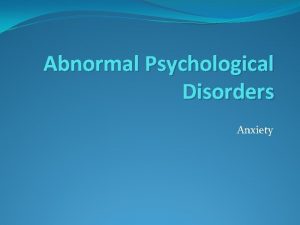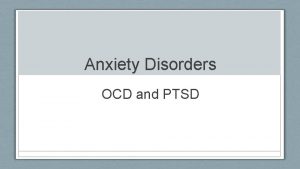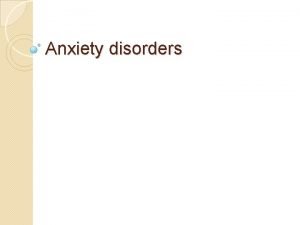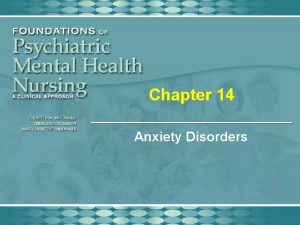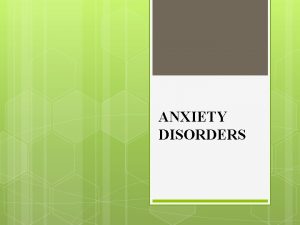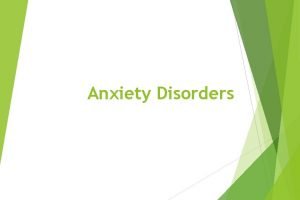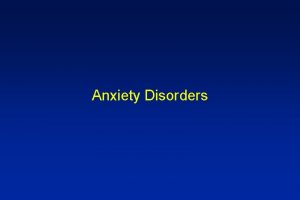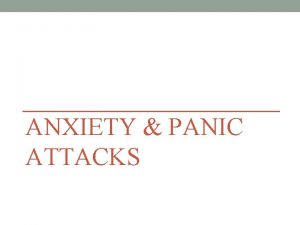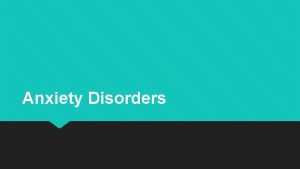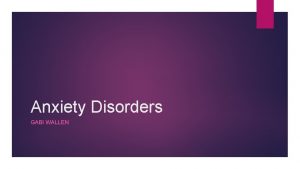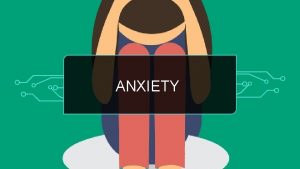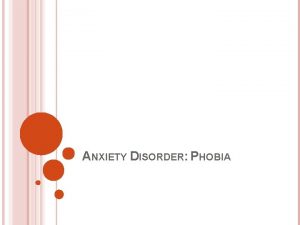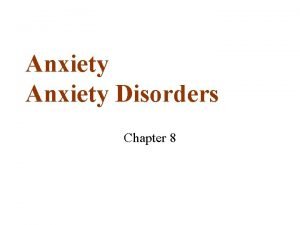Anxiety Disorders Chapter 19 Concept of Anxiety p






















































- Slides: 54

Anxiety Disorders Chapter 19

Concept of Anxiety p Uncomfortable feeling of apprehension or dread p Response to internal or external stimuli p Physical, emotional, cognitive, and behavioral symptoms

Normal vs. Abnormal p Intensity p Cause Symptom Cluster See Table 19. 1 Symptoms of Anxiety See Table 19. 2 for Degrees of Anxiety (Peplau’s model) p p p n n Mild Moderate Severe Panic

Anxiety Disorders p Up to 19 million of people in US p Higher in women p Individuals < 45 p Separated, divorced p Experienced childhood sexual abuse p Low socioeconomic groups

Panic p Extreme overwhelming form of anxiety when individual placed in a life-threatening (or perceived) situation p Normal becomes abnormal when panic is experienced routinely or in situations that do not pose threats

Panic Disorder p Experience panic in non-threatening situations p Panic attack p n Discrete periods of fear or discomfort (10 -30 minutes) n Physical (palpitations, rapid pulse, trembling, SOB) n Cognitive(disorganized thinking, irrational fears, fear going crazy, going to die) Phobias: persistent, unrealistic fears (see box 19. 2)

Clinical Course of Panic Disorder p Lifelong disorder, peaks in teenage years and again in 30 s p Chronic conditions that has several exacerbations and remissions during the course of the disease p Characterized by disabling attacks of panic that lead to other symptoms, such as phobia

Panic Attacks p Similar symptoms as heart attack, palpitation, heart racing, rapid breathing, shortness of breath (25% of ER visits for chest pain) p Types p n Unexpected cued n Situational cued (exposure to trigger) n Situational predisposed Diagnostic Criteria - table 19. 3 n n With agoraphobia Without agoraphobia

Special Populations p p Children n Most frequent psychiatric disorder n Often have separation anxiety and OCD Elderly people n Very common

Epidemiology of Panic Disorder p 2. 9 million people p Panic disorder with agoraphobia --most severe n comorbid anxiety disorders n Number of attacks n Anticipatory anxiety p Women more likely than men to experience panic disorder with agoraphobia p No difference between white and African American, Hispanic has lower

Etiology Biological Evidence and Theories p p p Genetic predisposition: substantial Neuroanatomic changes n Focal areas of abnormal activity in the fear network Biochemical changes n Panicogenic substances that produce panic attacks p yohimbine, fenfluamine, norepinephrin, epinephrine, sodium lactate, and carbon dioxide n Norepinephrine and locus ceruleus Stimulate locus ceruleus, increased fear p Inhibit locus ceruleus are anxiolytic p Yohimbine - antagonist 2 - panicogenic Serotonin- implicated, SSRI’s provide relief after 2 -6 wks, p n n initially, may increase anxiety GABA- stimulation cause anxiolytic, sedating effects

Etiology (Cont. ) p p p CRF n Neuropeptide that produces neuroendocrine, autonomic, and behavioral responses to stress n Severe stress results in an increased CRF concentrations in hippocampus, amygdala, locus ceruleus n CRF stimulations tests are conflicting n Long term use of SSRI antidepressants may inhibit release of CRF Cholesyctokinin (CCK) -- neuropeptide n High concentrations found in cerebral cortex, amygdala, and hippocampus n Important interactions with other neurotransmitters Carbon dioxide -- needs more study

Psychological Theories p Psychanalytic and psychodynamic theories n n p Explain the importance of development of anxiety Commonalities of background and personality traits § Fearful or shy as a child § Remembering parents as angry, critical § Feelings of discomfort with aggression § Long-term feelings of low self-esteem § Experiencing stressful events prior to initial onset Cognitive-behavioral theories n n n Fear response can be learned--classical conditioning Interoceptive conditioning--pairing a somatic discomfort with impending panic attack Catastrophic interpretation--misinterpretation of mild physical sensations

Risk Factors Family history p Substance and stimulant use or abuse p Undertaking severe stressors p Genetic predisposition p Female gender p For children p n n physical or sexual abuse behavioral inhibition by adults

Comorbidity p More somatic complaints than general populations p Vertigo, cardiac disease, GI disorders, asthma p Mitral valve prolapse, migraine headaches, and hypertension

Treatment p Interdisciplinary care is needed. p Priority care issues include n Depression associated with panic disorder n Suicide needs to be assessed

Nursing Management: Biologic Domain p Rule out other disorders p Assessment questions p Common features of panic attack. Careful review of events prior to attack p Substance use p Sleep patterns p Physical activity

Nursing Diagnosis Biologic Domain p Anxiety p Risk for self-harm p Risk of suicide

Biologic Interventions p Breathing control -- reduce hyperventilation and interrupt a panic attack. Need to practice p Nutritional planning reduce anxiety provoking substances: caffeine, food coloring or MSG n monitor symptoms after eating n p Relaxation techniques (Increase physical activity) Box 19. 3

Psychopharmacologic Treatment p p p p Selective serotonin reuptake inhibitors (SSRI) Fluoxetine and sertraline -- can cause feelings of overstimulation, slow titration Side effects -- anticholinergic, dizziness, anxiety, nervousness, and sexual dysfunction Interact with MAOIs Fluoxetine interacts with flecainid, warfarin, phenytoin, carbamazepine, and vinblastine Paroxetine interacts with cimetidine, decrease digoxin levels, phobarbitol, and phenytoin Sertraline interacts with diazepan and tolbutamide, warfarin Teaching points: p p Avoid over-the-counter medications Sedative effects may impede judgment while operating machinery

Psychopharmacologic Treatment p p p p p Tricylcic antidepressants Imipramine, nortriptyline and clomipramine reduce panic attacks Therapeutic effects usually occur in 3 -4 weeks Single bedtime doses help deals with sedation EKG before initiation (cardiac conduction) Taper discontinuation to avoid cholinergic rebound Observe for anticholinergic effects Start at low doses and gradually increase Interacts with several medications (MAOIs, and CNS depressants) Teaching points p p p Take medication as prescribed Avoid OTC medications without checking first Warn about sedation, avoid operating machinery

Psychopharmacologic Treatment p p p p p Benzodiazepines Used during periods of extreme stress and for immediate symptom release Alprazolam, lorazepam, and clonazepam Initiate benzodiazepines until antidepressants begin working Short acting associated with rebound anxiety ( alprazolam, lorazepam). Give in divided doses Avoid if sleep apnea Withdrawal symptoms can occur Side effects: headache, confusion, dizziness, disorientation, sedation, and visual disturbances Interactions with TCAs, digoxin, alcohol, and other CNS depressants. Avoid histamine blockers. Cigarette smoking increases clearance Teaching points: avoid alcohol, sedative effects

Nursing Management: Psychlogical Assessment p Determining patterns of panic attack, symptoms, and responses p Mental status : restlessness, irritability, watchful or worried facial expression, decreased attention span, difficulty problem solving, apprehensive, or helpless, selfreport scales p Suicidal assessment p Cognitive thought patterns p Self-concept p Rating scales (text box 19. 6, table 19. 5)

Nursing Diagnoses Psychological Domain p Anxiety p Risk for self-harm p Powerlessness

Psychological Interventions p p p p p Help patient attend to and react to input other than subjective experience (table 19. 7) Provide patient with information Distraction Positive self-talk “I will get through this” Panic control treatment: structured exposure to internal sensations Exposure therapy Systematic desensitization Implosive therapy Cognitive-behavioral therapy Psychoeducation

Nursing Management Social Domain Assessment p Family functioning p Cultural factors

Social Interventions p Stress time management p Family support n Help with communication

Emergency Care Interventions for Panic Attack p Stay with the patient p Reassure that you will not leave p Give clear directions p Assist patient to an environment with minimal stimulation p Walk with the patient p Administer PRN anxiolytic medications

Obsessive-Compulsive Disorder Severe obsessions or compulsions that interfere with life p Obsessions p n n n unwanted thoughts, intrusive persistent thoughts, impulses or images that cause anxiety and distress fear of contamination

Obsessive-Compulsive Disorder Compulsions repetitive behaviors performed in a ritualistic way that relieve anxiety

Special Populations OCD p p Children n 1%-2. 3% of child and adolescent population n ritualistic behaviors are typical of childhood n parents begin to notice grades fall because of decrease concentration Elderly n can occur in adulthood

OCD p 2. 5% lifetime prevalence of individuals p Similar rates in men and women p First-degree relatives most common p Less common in African Americans p Highly somatic p Comorbid anxiety disorders, personality disorders

Etiology Biologic Domain p Genetic p p p Neuropathologic p p first degree relatives monozygotic twins Abnormalities in frontal cortex, limbic system, and basal ganglia PET scans (see Ch. 18, Fig. 18 -3) Increased glucose metabolism in caudate nuclei, orbitofrontal gyri, and the cingulate gyri Biochemical p p Serotonin implicated (because of SSRIs) Others probably involved

Etiology Psychological Theories p Psychodynamic n n p symptoms and character traits arise from unconscious defense mechanisms: isolation, undoing, and reaction formation not scientifically tested Behavioral n n n based on learning theory obsessions seen as conditioned stimuli compulsions develop to reduce obsessional anxiety

Risk Factors p Infection with -hemolytic streptococci p Young p Divorced p Separated p Unemployed

Treatment p Interdisciplinary n p Staff needs to be consistent in expectations Priority Care Issues n Suicide

Common Reponses p p Obsessions create anxiety and compulsions are performed to reduce anxiety Common compulsions p p Most common obsessions p p washing, cleaning, checking, counting, repeating actions ordering, making confessions, and requesting assurances if sequence disturbed, person experiences anxiety fear of contamination, resulting compulsion toward handwashing Dissociation: a breakdown in integrated functions of memory, consciousness, perception of self, environment, or sensory and motor behavior p p Depersonalization: loss of sense of personality Coexists with Tourette’s Syndrome

Nursing Management Biologic Domain p Assess for multiple physical symptoms p Physical fears p Physical consequences of compulsions p Nutrition and sleep status p Dermatologic lesions secondary to hand washing p Head trauma

Biologic Interventions Electroconvulsive therapy p Psychosurgery p Maintaining skin integrity p Psychopharmacologic treatment p n n SSRI and TCA Antidepressants given in higher doses than for treatment of depression Side effect monitoring a problem for those preoccupied with somatic concerns Teaching points: medication management, do not stop prescribed medications abruptly, avoid OTC medications, consider sedative effect

Nursing Management Psychological Assessment p Type and severity of obsessions and compulsions p Degree to which the OCD symptoms interfere with patient’s daily functioning p Consider using rating scales (Text Box 21. 5) p Suicide assessment

Psychological Interventions p Response prevention p Thought stopping p Relaxation techniques p Cognitive restructuring p Cue Cards (Text Box 21. 6) p Psychoeducation (See Psychoeducation Checklist)

Nursing Management Social Domain p Consider sociocultural factors and ability to relate to others p In hospital, unit routines carefully and clearly explained to decrease patient’s fear of unknown p Recognize significance of rituals p Assist patient in arranging schedule p Marital and family support important

Nursing Management p Social interventions Milieu interventions n Personal and environmental protective measures n Family interventions n p Evaluation p Continuum of care

General Anxiety Disorder p Worry obsessively and interferes with life p Very common -- 5% will experience it in their life p Onset gradual p Comorbid psychiatric disorders, mild depressive symptoms common p Associated with alcoholism

GAD Etiology p Neurochemical theories (little research) p Genetic theories (moderately inherited) p Psychological theories p n inaccurate assessment of environment n selective focus on negative details, distorted information, processing, and overly pessimistic view Social theories (no specific theories) n High-stress lifestyle n Multiple stressful events

Risk Factors p Unresolved conflicts p Cognitive misinterpretations p Life stressors p Genetic predisposition p Behavioral inhibition

Nursing Management Biologic Domain Assessment p Diet n and nutrition may be hypersensitive to caffeine p Sleep n patterns disturbances are common p Substance use

Nursing Interventions Biologic Domain p Medications Buspirone (Buspar) n Antidepressants n p Nutrition counseling p Sleep hygiene

Psychosocial Domain p Assessment and interventions similar to panic disorder p Cognitive psychotherapy is effective treatment of GAD p Outcomes include reducing frequency and intensity of anxiety and controlling factors that contribute to anxiety

Other Anxiety Disorders p Specific p Social Phobia p PTSD (discussed later) p Acute Stress Disorder

Dissociative Disorders p Dissociative amnesia p Dissociative fugue p Depersonalization p Dissociative disorder Identity Disorder

General Anxiety Disorder p Evaluation p Continuum of care

Dissociative Disorders p Failure to integrate identity, memory, and consciousness p Types n Dissociative amnesia -- inability to recall n Dissociative fugue -- unexpected travel away from home n Depersonalization disorder -- being detached for one’s body n Dissociative identity disorder (multiple personality disorder) n Dissociative disorder not otherwise specified

Anxiety Disorders
 Chapter 15 anxiety and obsessive-compulsive disorders
Chapter 15 anxiety and obsessive-compulsive disorders Anxiety disorders def
Anxiety disorders def Icd 10 cemas
Icd 10 cemas Multipath model of anxiety disorders
Multipath model of anxiety disorders Chapter 11 genetic disorders concept mapping
Chapter 11 genetic disorders concept mapping Chapter 8 managing stress and anxiety
Chapter 8 managing stress and anxiety Chapter 18 managing anxiety
Chapter 18 managing anxiety Chapter 5 lesson 1 dealing with anxiety and depression
Chapter 5 lesson 1 dealing with anxiety and depression Chapter 5 lesson 1 dealing with anxiety and depression
Chapter 5 lesson 1 dealing with anxiety and depression Chapter 18 psychological disorders review worksheet
Chapter 18 psychological disorders review worksheet Chapter 8 skin disorders and diseases
Chapter 8 skin disorders and diseases Chapter 6 musculoskeletal system
Chapter 6 musculoskeletal system Chapter 46 digestive and endocrine disorders
Chapter 46 digestive and endocrine disorders Types of somatic disorder
Types of somatic disorder Chapter 29 endocrine and metabolic disorders
Chapter 29 endocrine and metabolic disorders Chapter 21 mental health diseases and disorders
Chapter 21 mental health diseases and disorders Chapter 18 psychological disorders
Chapter 18 psychological disorders Chapter 18 eating and feeding disorders
Chapter 18 eating and feeding disorders Chapter 17 reproductive system diseases and disorders
Chapter 17 reproductive system diseases and disorders Chapter 15 nervous system diseases and disorders
Chapter 15 nervous system diseases and disorders Chapter 14 psychological disorders
Chapter 14 psychological disorders Chapter 14 depressive disorders
Chapter 14 depressive disorders Chapter 11 childhood and neurodevelopmental disorders
Chapter 11 childhood and neurodevelopmental disorders Glencoe health chapter 5 vocabulary
Glencoe health chapter 5 vocabulary Elsevier
Elsevier Chapter 5 mental and emotional problems
Chapter 5 mental and emotional problems 10 nail diseases and disorders
10 nail diseases and disorders Nail diseases and disorders milady
Nail diseases and disorders milady Cardiovascular system diseases and disorders chapter 8
Cardiovascular system diseases and disorders chapter 8 Milady chapter 8 skin disorders and diseases
Milady chapter 8 skin disorders and diseases Chapter 14 psychological disorders
Chapter 14 psychological disorders Ap psychology chapter 15 psychological disorders
Ap psychology chapter 15 psychological disorders Chapter 55 care of patients with stomach disorders
Chapter 55 care of patients with stomach disorders Chapter 47 urinary and reproductive disorders
Chapter 47 urinary and reproductive disorders Chapter 17 somatic symptom disorders
Chapter 17 somatic symptom disorders Chapter 12 schizophrenia spectrum disorders
Chapter 12 schizophrenia spectrum disorders An extreme harmful eating behavior
An extreme harmful eating behavior 10 diseases of lymphatic system
10 diseases of lymphatic system Is schizophrenia on a spectrum
Is schizophrenia on a spectrum What is ideal self meaning
What is ideal self meaning Perbedaan selling concept dan marketing concept
Perbedaan selling concept dan marketing concept Igor areh
Igor areh Relaxation techniques test anxiety
Relaxation techniques test anxiety Test taking anxiety symptoms
Test taking anxiety symptoms I'm a perfect example of someone who has math anxiety
I'm a perfect example of someone who has math anxiety Neurotic anxiety example
Neurotic anxiety example Anxiety mnemonic
Anxiety mnemonic Nursing diagnosis for anxiety
Nursing diagnosis for anxiety Examples of generalized anxiety disorder
Examples of generalized anxiety disorder Neurotic anxiety example
Neurotic anxiety example Ocd symptoms checklist
Ocd symptoms checklist University of wisconsin integrative medicine anxiety
University of wisconsin integrative medicine anxiety Astrid zamora
Astrid zamora Frustration anxiety and tension
Frustration anxiety and tension Mecbal
Mecbal

